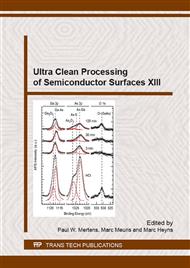[1]
Sara Case, Stephanie Waite, John Barker, Wei Zhao, Jong Soo Kim, Joshua Moore, Eswar Ramanathan; Impact of FOUP Environment on Product Yield in Advanced Technologies ; IEEE, 2016; pp.168-171.
DOI: 10.1109/asmc.2016.7491118
Google Scholar
[2]
Thi Quynh Nguyen, Hervé Fontaine, Yannick Borde, Véronique Jacob, Identification and quantification of FOUP molecular contaminants inducing defects in integrated circuits manufacturing, Microelectronic Engineering, vol. 105, 2013, pp.124-129.
DOI: 10.1016/j.mee.2012.04.008
Google Scholar
[3]
Hervé Fontaine, H. Feldis, A. Danel, S. Cetre, C. Ailhas, Impact of the volatile Acid Contaminant on Copper Interconnects, Electrical Performances. ECS Transactions, 25(5), 2009, pp.78-86.
DOI: 10.1149/1.3202638
Google Scholar
[4]
K. Mikkelsen and T. Niebeling, "Characterizing FOUPs and evaluating their ablity to prevent wafer contamination, Mirco journal, March (2001).
Google Scholar
[5]
J. Bounouar, T. Q. Nguyen, O. Le-Barillec, A. Favre, E. Veran, I. Stassen, A. Gettel, FOUP Material Influence on HF Contamination during Queue-Time, Solid State Phenomena (Volume 219); pp.251-255.
DOI: 10.4028/www.scientific.net/ssp.219.251
Google Scholar
[6]
Schneider, G., Wagner, T., Kraft, M. (2015).
Google Scholar
[7]
S. Rank, C. Hammel, G. Schneider, T. Schmidt: REDUCING SIMULATION MODEL COMPLEXITY BY USING AN ADJUSTABLE BASE MODEL FOR PATH-BASED SYSTEMS – A CASE STUDY IN THE SEMICONDUCTOR NDUSTRY, Proceedings of the 2015 Winter Simulation Conference.
DOI: 10.1109/wsc.2015.7408393
Google Scholar


